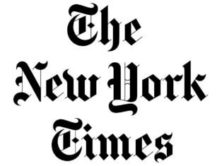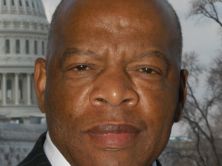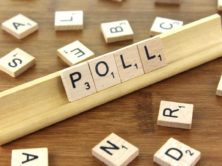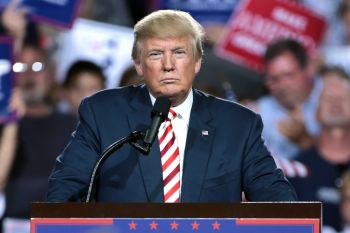
Donald Trump in 2016 (Credit: Wikipedia/Gage Skidmore)
News reports have suggested that President Trump was getting a bounce in popularity as a consequence of the White House daily briefings about the coronavirus pandemic. Others suggested that whatever bounce he got was either minor or had already fizzled.
Then just as more polls confirmed that Trump’s bounce may have disappeared, a Fox poll announced that Joe Biden and Donald Trump were now tied in the race for president. That was significant, because only two weeks earlier, Fox showed Biden up by nine points.
In contrast to Fox’s finding of a tie, five other polls, which also took the pulse of the electorate in the same time period, showed Biden in the lead by four to 11 percentage points.
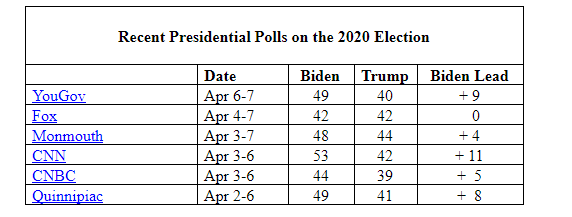
The Fox poll is conducted by the joint efforts of a Republican firm (Shaw & Company) and a Democratic firm (Beacon Research), and is highly rated by FiveThirtyEight. In January, February, and March, Fox found Biden leading Trump by 8, 8, and 9 points, respectively. Shaw & Company’s Daron Shaw explained the decline in Biden’s lead as measured by the April poll:
“A global pandemic and Trump’s daily press conferences appear to have revved up Republicans and quieted Democratic voters.”
But there is another possible explanation for why the Fox poll is an outlier. In this poll, unlike previous Fox polls, when Democrats outnumbered Republicans by a significant margin, there were equal numbers of Democrats and Republicans in the sample. Dana Blanton, Director of the Fox Poll, writes:
“Trump is helped by the highest number of voters identifying as Republican in nearly a year. While Democrats typically hold an edge over Republicans nationally in party identification, this can shift based on events and changing sentiment. For some time, voters have been more likely to align as Democrats than as Republicans. In Fox News polls over the last year, there has been a seven percentage-point Democratic advantage, on average. In this poll, equal numbers of voters identify as Democrat and Republican.”
While party identification can fluctuate from poll to poll, the size of this change within a two-week period is a bit unusual. Still, the Fox poll found that Biden’s decline had occurred even among Democrats – down seven points (87% to 80%) between the April poll and the March poll. Why Biden’s support might have fallen that much among Democrats in that two-week period is unclear.
In contrast to Fox, the Monmouth poll – conducted over four days, including the three days of the Fox poll – concluded that the coronavirus crisis has had little impact on the election. But the poll also showed a narrower lead in March than did Fox – Biden up by three points then, and four points now. The report noted that Trump’s favorability rating took a dip, while Biden’s remained stable. But overall, according to Patrick Murray, Director of the Monmouth University Polling Institute:
“The static nature of these results suggests the president’s response to the pandemic is certainly not helping his reelection prospects.”
Apparently, the results also suggested the response was not hurting his reelection prospects either.
The CNBC poll – like the Fox poll – shows a decline in Biden’s lead from the previous month, but by a much smaller margin. In April the poll reports Biden ahead by five points, 44% to 39%, down from eight and nine points, respectively, in February and March. In both those months, Biden got 52% of the vote. In April, his support dropped eight points. But Trump’s support also dropped – by four points. All these changes are well within the margins of error of the polls, suggesting they are just normal statistical fluctuations, and that perhaps little real change in voter opinion actually occurred.
As for the other three polls, nothing in their results suggests a significant change in the presidential race over the past several weeks. The Quinnipiac poll shows Biden’s support hovering around the 50% mark in five polls that go back to October, 2019, while Trump’s support averages about 41% over the same period.
The CNN poll also shows little change over the past several months. For January, March and April, Biden’s support has been consistent at 53%, while Trump’s has averaged 42%.
And the YouGov poll, if anything, shows Biden’s lead actually increasing from early March until now – a 4-point lead in early March (45% to 41%), a 6-point lead in late March (46% to 40%), and a 9-point lead now (49% to 40%).
It should be noted that the YouGov’s election question was #48 in the survey, after several questions about the coronavirus crisis, including how well the administration had handled the crisis. One that seemed particularly biased asked:
How much could President Trump have reduced the damage done by coronavirus if he had acted sooner?
A lot (40%)
Somewhat (25%)
Slightly (14%)
No effect (22%)
This question essentially assumes that Trump could have reduced the damage if he had acted sooner, which not all Americans necessarily accept. A more neutral way of asking the question would have been to ask it in two parts: Do you think President Trump could have reduced the damage done by coronavirus if he had acted sooner, or don’t you think so? For those who say he could have reduced the damage by acting sooner, then ask: How much could he have reduced the damage – a lot, somewhat, or only a little? As it is, the question gives three responses that are negative toward Trump, and only one that is positive.
In any case, asking many policy questions before the election question, especially questions that are biased against one candidate or the other, can distort the picture of what the electorate actually thinks. In polls leading up to the election, most pollsters will ask the candidate preference question very early in the survey, in order to avoid influencing how voters might answer. But, unfortunately, during the campaign, many pollsters will ignore that caution and ask many questions prior to the candidate preference question.
So, what should we make of the divergent findings of the polls?
It appears as though the Fox poll is an outlier at one end of the spectrum, but it also appears that the CNN poll is an outlier at the other end. This kind of pattern is what should be expected from well-conducted polls. There is bound to be some variation around a mean, with some polls at the upper end and others at the lower end. That doesn’t mean the outliers are “wrong.” They provide the boundaries of possibilities, and need to be included in any assessment of the true state of voter opinion.
And sometimes, the outliers turn out to be the most predictive.

